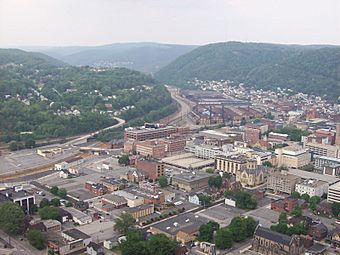Downtown Johnstown Historic District facts for kids
Quick facts for kids |
|
|
Downtown Johnstown Historic District
|
|

Downtown Johnstown, February 2006
|
|
| Location | Bounded by Washington, Clinton, Bedford, Vine, Market, Locust and Walnut Sts., Johnstown, Pennsylvania |
|---|---|
| Area | 50 acres (20 ha) |
| Built | 1889 |
| Architect | Multiple |
| Architectural style | Second Empire, Art Deco, Romanesque |
| NRHP reference No. | 92000941 |
| Added to NRHP | August 7, 1992 |
The Downtown Johnstown Historic District is a special area in Johnstown, Pennsylvania. It's like a time capsule of buildings! This district is recognized as a historic district because of its important past. It includes 109 old buildings, 4 historic sites, and 1 structure. These are mostly in the main part of Johnstown and some nearby neighborhoods.
Many buildings here were built between 1890 and 1930. This was after a very big event in Johnstown's history. Some buildings are even older, from before that event. The district was added to the National Register of Historic Places in 1992. This means it's officially recognized as important to the history of the United States.
Contents
What Makes This District Special?
This historic district covers about 50 acres. It shows how Johnstown rebuilt itself after a terrible flood. The architecture styles you can see include Second Empire, Art Deco, and Romanesque. These are different ways buildings were designed long ago.
Buildings from the Past
You can find many interesting buildings in the district. Some were built before the famous Johnstown Flood of 1889. For example, the Alma Hall (built in 1884) and the Stenger Dry Goods Store (1883) are older. Most buildings, however, were built after the flood. They show how the city grew back.
After the Great Flood
The Johnstown Flood happened in 1889. It destroyed much of the city. After the flood, people worked hard to rebuild. Many new buildings went up between 1890 and 1930. These buildings show the spirit of Johnstown. They include places like the Widmann Building (1892) and the Swank Building (1907).
Important Buildings to See
There are many cool buildings in the district. The Johnstown City Hall (1900) is one example. It's where the city's government works. The former U.S. Post Office (1912) is another. It used to handle all the mail. The State Theater (1926) was a place for movies and shows.
You can also see several churches. These include the Franklin Street United Methodist Church (1869) and the beautiful St. John Gualbert Cathedral (1896). Other notable places are the Elks Building (1903) and the Moose Building (1917). These were social clubs.
Some buildings in the district are so important they are listed separately. These include the Cambria Public Library Building, the G.A.R. Hall, and Nathan's Department Store. Each has its own unique story.
Gallery





